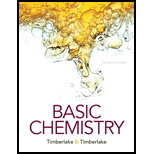
Concept explainers
(a)
Interpretation:
Among the given terms, correct term should be matched for the portion of an enzyme where catalytic activity takes place.
(1) Active site (2) Lock-and-key model (3) Induced-fit model
Concept Introduction:
An enzyme is also a protein which has the capability to bind with the substrate (reactant molecule) by recognizing it. Enzymes have a unique three-dimensional shape which helps them in binding to the substrate. The size of an enzyme is typically larger than that of the substrate, and it contains a region known as active site within its structure. This active site is responsible for binding the substrate and thus catalyzing the given reaction.
(b)
Interpretation:
Among the given terms, the correct term should be matched for the active site that adapts to the shape of the substrate.
(1) Active site (2) Lock-and-key model (3) Induced-fit model
Concept Introduction:
An enzyme is also a protein which has the capability to bind with the substrate (reactant molecule) by recognizing it. Enzymes have a unique three-dimensional shape which helps them in binding to the substrate. The size of an enzyme is typically larger than that of the substrate, and it contains a region known as active site within its structure. This active site is responsible for binding the substrate and thus catalyzing the given reaction.
(c)
Interpretation:
Among the given terms, the correct term should be matched for an active site that has a rigid shape.
(1) Active site (2) Lock-and-key model (3) Induced-fit model
Concept Introduction:
An enzyme is also a protein which has the capability to bind with the substrate (reactant molecule) by recognizing it. Enzymes have a unique three-dimensional shape which helps them in binding to the substrate. The size of an enzyme is typically larger than that of the substrate, and it contains a region known as active site within its structure. This active site is responsible for binding the substrate and thus catalyzing the given reaction.
Want to see the full answer?
Check out a sample textbook solution
Chapter 18 Solutions
Basic Chemistry (5th Edition)
- The temperature on a sample of pure X held at 1.25 atm and -54. °C is increased until the sample boils. The temperature is then held constant and the pressure is decreased by 0.42 atm. On the phase diagram below draw a path that shows this set of changes. pressure (atm) 2 0 0 200 400 temperature (K) Xarrow_forwardQUESTION: Answer Question 5: 'Calculating standard error of regression' STEP 1 by filling in all the empty green boxes *The values are all provided in the photo attached*arrow_forwardpressure (atm) 3 The pressure on a sample of pure X held at 47. °C and 0.88 atm is increased until the sample condenses. The pressure is then held constant and the temperature is decreased by 82. °C. On the phase diagram below draw a path that shows this set of changes. 0 0 200 temperature (K) 400 аarrow_forward
- er your payment details | bar xb Home | bartleby x + aleksogi/x/isl.exe/1o u-lgNskr7j8P3jH-1Qs_pBanHhviTCeeBZbufuBYT0Hz7m7D3ZcW81NC1d8Kzb4srFik1OUFhKMUXzhGpw7k1 O States of Matter Sketching a described thermodynamic change on a phase diagram 0/5 The pressure on a sample of pure X held at 47. °C and 0.88 atm is increased until the sample condenses. The pressure is then held constant and the temperature is decreased by 82. °C. On the phase diagram below draw a path that shows this set of changes. pressure (atm) 1 3- 0- 0 200 Explanation Check temperature (K) 400 X Q Search L G 2025 McGraw Hill LLC. All Rights Reserved Terms of Use Privacy Cearrow_forward5.arrow_forward6.arrow_forward
 ChemistryChemistryISBN:9781305957404Author:Steven S. Zumdahl, Susan A. Zumdahl, Donald J. DeCostePublisher:Cengage Learning
ChemistryChemistryISBN:9781305957404Author:Steven S. Zumdahl, Susan A. Zumdahl, Donald J. DeCostePublisher:Cengage Learning ChemistryChemistryISBN:9781259911156Author:Raymond Chang Dr., Jason Overby ProfessorPublisher:McGraw-Hill Education
ChemistryChemistryISBN:9781259911156Author:Raymond Chang Dr., Jason Overby ProfessorPublisher:McGraw-Hill Education Principles of Instrumental AnalysisChemistryISBN:9781305577213Author:Douglas A. Skoog, F. James Holler, Stanley R. CrouchPublisher:Cengage Learning
Principles of Instrumental AnalysisChemistryISBN:9781305577213Author:Douglas A. Skoog, F. James Holler, Stanley R. CrouchPublisher:Cengage Learning Organic ChemistryChemistryISBN:9780078021558Author:Janice Gorzynski Smith Dr.Publisher:McGraw-Hill Education
Organic ChemistryChemistryISBN:9780078021558Author:Janice Gorzynski Smith Dr.Publisher:McGraw-Hill Education Chemistry: Principles and ReactionsChemistryISBN:9781305079373Author:William L. Masterton, Cecile N. HurleyPublisher:Cengage Learning
Chemistry: Principles and ReactionsChemistryISBN:9781305079373Author:William L. Masterton, Cecile N. HurleyPublisher:Cengage Learning Elementary Principles of Chemical Processes, Bind...ChemistryISBN:9781118431221Author:Richard M. Felder, Ronald W. Rousseau, Lisa G. BullardPublisher:WILEY
Elementary Principles of Chemical Processes, Bind...ChemistryISBN:9781118431221Author:Richard M. Felder, Ronald W. Rousseau, Lisa G. BullardPublisher:WILEY





